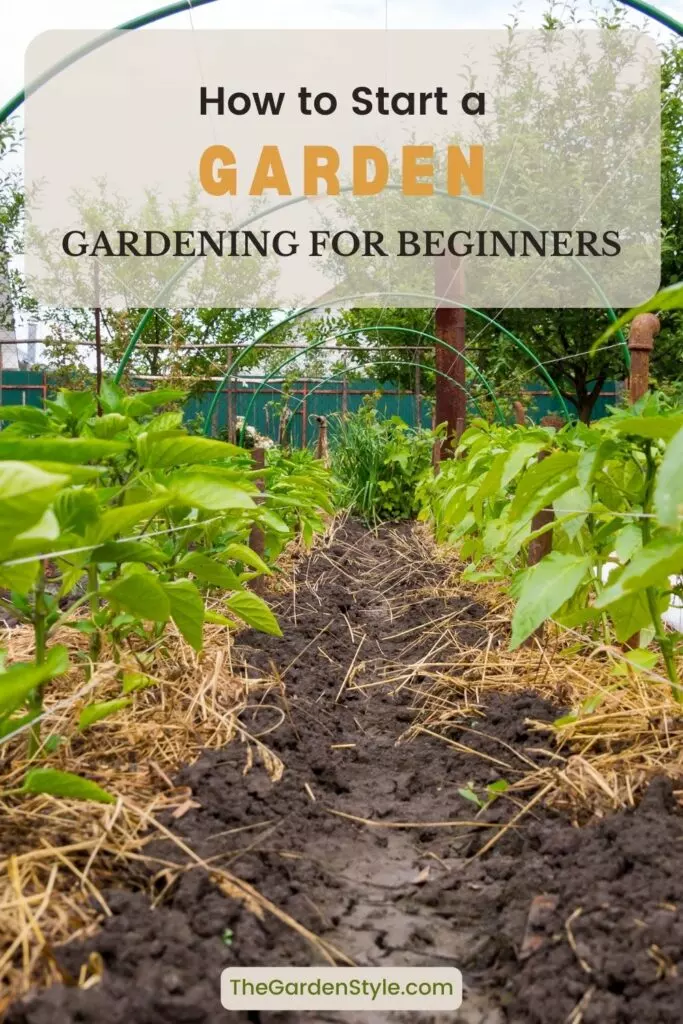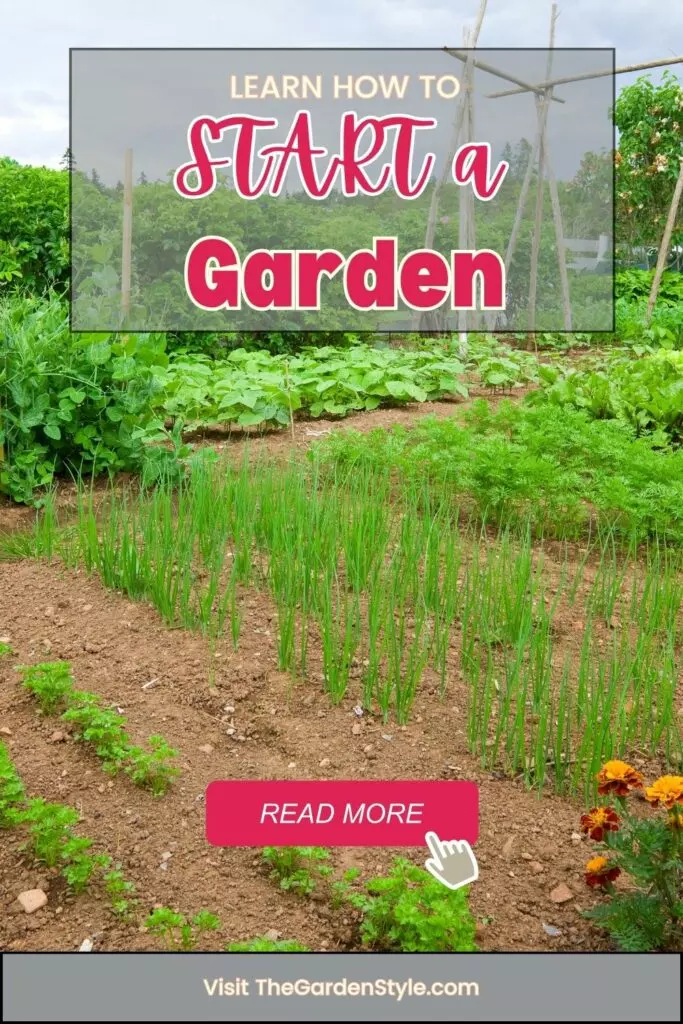A home garden not only produces fresh vegetables and flowers but also provides relaxation and a sense of accomplishment. Starting one may seem daunting for beginners, but it is very achievable if you follow some key steps. This comprehensive guide covers everything from essential planning and laying out to ongoing garden care for a successful start with the knowledge needed to cultivate a thriving garden. Learn to select the right plants and understand soil conditions to design an efficient garden and manage pests. This guide is meticulously crafted to cater specifically to beginners, providing a step-by-step roadmap and essential insights to ensure a successful and enjoyable understanding of how to start your first garden. Let’s start.
Table of Contents
Key Takeaways
- Sunlight, soil quality, and efficient drainage are essential for successful gardening.
- Select the right tools and garden location for optimal gardening experience.
- Choose and plant crops based on personal food preferences and ideal planting times.
- Set up an efficient watering system and regularly maintain it for optimal plant hydration.
- Prune, trim, weed, mulch, and fertilize your garden to promote healthy plant growth.
- Consider companion planting and selecting disease-resistant varieties to enhance growth and deter pests.
Understanding the Basics of Gardening
To truly grasp the art of gardening, it’s essential to understand its foundational components: the vital roles of sunlight, soil quality, and proper drainage, the importance of choosing an appropriate garden location and size, and the strategic selection of vegetables and planting times. This understanding lays the groundwork for the beginner’s guide to gardening, allowing for a comprehensive insight into how to start a vegetable garden.
- Sunlight is essential for photosynthesis, and understanding the basics of gardening requires knowledge of the sun-exposure needs of your chosen plants.
- Soil quality is vital as it provides the nutrients plants need for growth.
- Efficient drainage prevents water-logging, which can suffocate roots and lead to plant diseases.
- Choosing the right garden location and size depends on sun exposure, ease of access for maintenance, and space for plant growth. Starting your garden in a suitable location can significantly enhance its productivity and success.
- The strategic selection of vegetables and planting times can ensure a continuous harvest throughout the growing season.
- Understanding their growth habits, companion planting, and optimal planting times are valuable tips to help in creating a thriving garden.
Gardening for beginners can seem daunting, but with knowledge and planning, it can become an enjoyable and rewarding endeavor.
Basic Tools and Supplies for a Gardener Beginner
Equipping oneself with the right tools is a fundamental step for beginners commencing their gardening journey, as these instruments significantly contribute to the success of their gardening endeavors. Starting small is a crucial gardening tip for beginners.
Gardening essentials include trowels, gloves, pruners, hoses, sprinklers, rakes, stakes, cages, trellises, and row covers. Safety goggles may needed for certain tasks. Always sanitize your tools and keep them clean and out of rust.
When selecting tools, consider their durability and ease of use. The best time to get a good price is shopping at the end-of-season sales for deals.
Comfortable handles and rust-resistant materials add to the longevity of your investment.
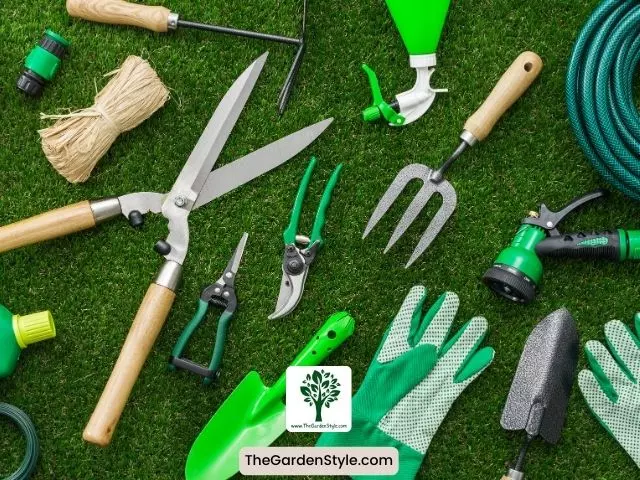
Planning Your First Garden
Select Location
One of the first things to think of when starting a garden is to choose the location. Whether you have a spacious backyard, a cozy balcony, or just a tiny corner to spare, the decision to start a garden is a versatile and rewarding choice that can be tailored to fit any space, offering endless possibilities for cultivating nature’s beauty right at home. Then, many choices that you will make in the process of creating a garden will be connected to the features of your location. For example, suppose your space is limited; you may want to grow vegetables on a trellis and create a vertical garden to save space.
Choose a sunny, level spot near a water source in well-drained soil with a pH of 6.5-7. Most vegetables need at least 6 hours of sun daily.
Having assembled a robust set of gardening tools, the next pivotal step in your gardening journey involves selecting the perfect garden location. This choice can significantly impact the success of your gardening endeavor, so take time to consider some critical factors.
Firstly, a sunny location is key as most vegetables and plants require 6-8 hours of direct sunlight daily. Your garden bed should be in a well-drained area to prevent waterlogging and root damage. Steer clear of windy or high-traffic areas, which may damage plants and disrupt their growth.
When starting, be realistic about the garden size. A smaller, manageable garden allows you to focus on maintaining healthy plants and learning the ropes. As you progress, you can gradually expand your garden plan.
Next, consider your personal food preferences. Select easy-to-grow vegetables for a rewarding start. Online garden planning tools can assist with garden design and plant selection, making the process less daunting for beginners.
Lastly, consider implementing a watering system. This will ensure consistent hydration and maintenance, a key factor in successful gardening.
Start Small
Limit yourself to 2-4 raised beds, 3 to 4 feet wide, for easier reach. Starting small allows you to add on later. Mark out dimensions with string.
Prepare Soil
To enhance the quality of your garden soil, it is essential to incorporate compost or aged manure into the earth, as this contributes to improved aeration and drainage. Utilizing a shovel or rototiller, work the compost or manure thoroughly into the soil, ensuring a uniform distribution.
Recommended reading: Types of Soil: Understanding the Different Varieties of Soil.
This process not only introduces valuable nutrients but also aids in breaking up clods and removing rocks, promoting a finer and more workable texture.
After tilling, use a rake to smooth the soil surface, creating an optimal foundation for planting.
This preparation ensures that your plants receive proper aeration, drainage, and nutrient access, setting the stage for healthy root development and robust growth in your garden.
Recommended reading: Mulch vs Topsoil: Understanding the Differences and Benefits
Pick Crops
When selecting crops for your first gardening venture, consider opting for ideal starter vegetables that promise both ease of cultivation and rapid growth.
Loose-leaf lettuce, radishes, and bush beans, known for their resilience and straightforward cultivation, are excellent choices for beginners. These vegetables not only provide a satisfying harvest but also serve as a great introduction to the joy of home gardening.
For crops like tomatoes, peppers, and broccoli, it is recommended to use transplants rather than starting from seeds. This involves transplanting pre-grown seedlings into your garden, offering a convenient way for beginners to kickstart the cultivation of these slightly more challenging but rewarding vegetables.
By choosing these starter crops and utilizing transplants where applicable, you can set yourself up for a successful and enjoyable gardening experience.
Recommended gardening guides for a beginner gardener:
How to Grow Tomatoes: A Guide for Beginner Gardeners
How to Plant Potatoes: A Guide for Beginners and Experts
Growing Eggplant Guide: Plant, Care, and Harvest
Timing
When is the right time to start a garden or to start planting? That’s key to a successful process. Know your seasonal schedules – when to start seeds or set transplants into the ground based on your region. Most planting happens in spring or fall. More details related to timing and the USDA hardiness zone are in the next section of this post.
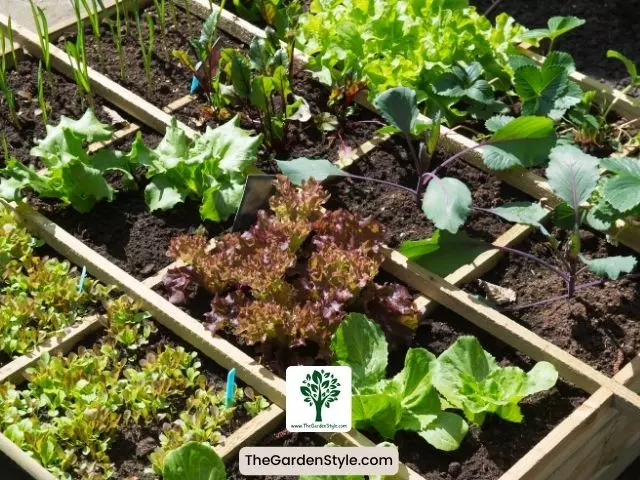
Layout for a Vegetable Garden and a Beginner Homestead
On the journey to starting the garden, beginners (and even experienced gardeners) often find the task of planning the layout challenging, requiring careful consideration to establish an arrangement that fosters optimal growth and visual harmony among the diverse plant selections.
Defining the layout for your homestead vegetable garden involves careful consideration of various factors to ensure optimal use of space, sunlight, and resources.
Deciding on the layout for your garden is a thoughtful process that cannot be rushed. It demands careful consideration of factors such as sunlight exposure, water requirements, and the growth habits of plants. Taking the time to make informed decisions ensures a well-organized and thriving garden in the long run.
Here are steps and considerations to help you decide on the layout:
Assess Available Space: Measure the available gardening space. Consider both the total area and the shape of the space. Note any obstacles like trees, structures, or uneven terrain.
Sunlight Analysis: Identify areas of full sun, partial shade, and full shade in your garden. Different vegetables have varying sunlight requirements, so plan your layout accordingly. Place sun-loving crops in areas with maximum sunlight exposure.
Divide into Zones: Divide your garden into functional zones based on factors like water accessibility, soil quality, and microclimates. This allows for better organization and management of different plant groupings.
Consider Companion Planting: Research companion planting principles to maximize space and create a harmonious environment. Certain plants benefit each other when grown together, either by enhancing growth or deterring pests.
Crop Rotation: Plan for crop rotation by designating areas for different plant families each season. This helps prevent the buildup of pests and diseases specific to certain crops while maintaining soil fertility.
Watering Infrastructure: Consider the placement of water sources, irrigation systems, and rain barrels. Efficient watering is critical for plant health, so ensure that water is easily accessible to all areas of your garden.
Garden Paths and Access Points: Plan for pathways between garden beds to allow easy access for planting, maintenance, and harvesting. This also helps prevent soil compaction and provides a neat and organized appearance.
Include Support Structures: If you plan to grow vertical crops or plants that require support, such as tomatoes or cucumbers, factor in structures like trellises, cages, or stakes in your layout.
Aesthetic Considerations: Consider the visual appeal of your garden. Arrange plants in an aesthetically pleasing manner, and think about color combinations and plant heights to create an attractive and functional layout.
Garden Infrastructure: Allocate space for essential elements like compost bins, tool storage, and seating areas. These elements contribute to the overall functionality and enjoyment of your garden.
Recommended reading: How to Keep Deer Out of the Garden
Start Small and Expand: If you’re a beginner, it’s often wise to start with a smaller garden and expand gradually. This allows you to manage the space effectively and learn from your experiences.
When establishing the layout for your garden, employ a triangular spacing method to optimize the use of available space effectively. For instance, when planting radishes, maintain a spacing of 2 inches between each plant, while for lettuce, leave a distance of 12 inches. This triangular arrangement minimizes wasted space and allows for efficient utilization of your garden plot.
Additionally, strategically position taller crops to avoid shading smaller, sun-dependent plants. Placing the taller crops in a way that they don’t cast shadows on the shorter ones ensures that each plant receives adequate sunlight, fostering healthy growth throughout the garden.
This thoughtful layout not only maximizes productivity but also creates a visually appealing and well-organized garden space. Remember that your garden layout can be a dynamic aspect that evolves over time. Observing how plants perform, considering your gardening goals, and learning from each growing season will help you refine and adjust your layout in the future.
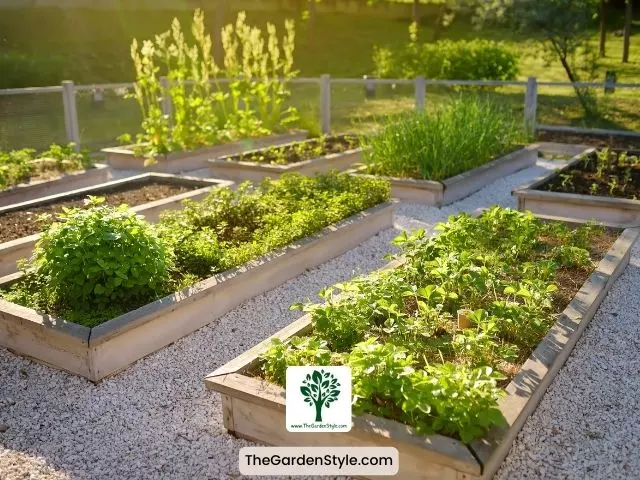
Raised Beds, In-Ground Beds, or Traditional Rows
Decide whether you want traditional rows, in-ground beds, or raised beds. Traditional rows might be more suitable for larger spaces. Gardeners often choose between raised beds and in-ground beds based on their specific gardening goals, preferences, and the needs of the plants they are cultivating.
For individuals seeking a more accessible and user-friendly gardening experience, the adoption of raised beds is a highly recommended approach. Raised beds offer a host of benefits, with one of the primary advantages being the elevated structure that brings the garden to a more manageable height. This design minimizes the need for bending or stooping, making it an ideal choice for those with mobility issues or back concerns. Additionally, the elevated nature of raised beds provides better drainage and aeration for the soil, creating an optimal environment for plant growth. The contained nature of these beds also helps in weed control and provides a clear delineation of gardening space.
The opposite of raised beds would be “ground-level beds” or simply “in-ground beds.” In-ground beds are garden beds that are at the same level as the surrounding soil, with no raised edges or borders. These beds are created by digging into the natural soil to create a planting area. Unlike raised beds, in-ground beds do not have elevated sides or edges. Gardeners often choose between raised beds and in-ground beds based on their specific gardening goals, preferences, and the needs of the plants they are cultivating.
Raised beds can be particularly beneficial for individuals facing various health challenges. Here are some instances where raised beds may be especially helpful:
Mobility Issues: Individuals with limited mobility, such as those with arthritis, back problems, or conditions affecting the lower extremities, may find raised beds more accessible. The elevated height reduces the need for bending or kneeling, making gardening tasks more manageable.
Wheelchair Users: Raised beds are well-suited for individuals who use wheelchairs. The raised height allows wheelchair users to reach and engage in gardening activities comfortably without having to navigate uneven ground.
Seniors: Older individuals, especially those with reduced flexibility and strength, can benefit from raised beds as they provide a more ergonomic and comfortable gardening experience. This promotes continued engagement in a beloved hobby without undue physical strain.
Chronic Illness: People with chronic illnesses that affect energy levels and physical capabilities may find raised beds easier to maintain. The reduced physical demand can make gardening a more feasible and enjoyable activity.
Rehabilitation: Individuals undergoing rehabilitation or recovering from surgery may opt for raised beds as they offer a controlled and accessible environment. Gardening can play a therapeutic role in the recovery process.
Sensory or Cognitive Impairments: Raised beds can be beneficial for those with sensory or cognitive impairments. The organized and contained nature of raised beds provides a clear and defined gardening space, making it easier for individuals with cognitive challenges to engage in gardening activities.
Respiratory Issues: Individuals with respiratory issues or allergies may find raised beds more manageable as they can better control the quality of the soil and reduce exposure to allergens commonly found in ground-level soil.
Community Gardens: In community gardens, where a diverse group of individuals with varying abilities may share the space, incorporating raised beds ensures inclusivity and allows everyone to participate in gardening activities comfortably.
Ultimately, the decision to use raised beds depends on individual needs and preferences. They offer a versatile solution for creating accessible and enjoyable gardening spaces for a wide range of people, including those facing health challenges.
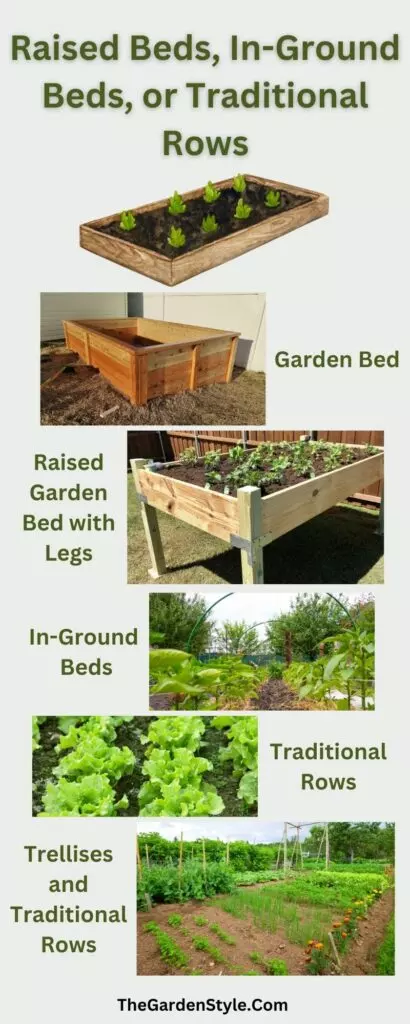
Choosing and Planting Your Crops
Now that you have selected an ideal location for your garden, it’s time to delve into the crucial process of choosing and planting your crops or edible flower garden. The type of crops you choose will largely depend on your personal and family’s food preferences, as well as what’s available at your local grocery store.
To aid you in this process, consider using a garden planning tool. This can help you design a feasible layout, select suitable plants, and determine the appropriate spacing for each type of crop. It’s also vital to be aware of the ideal planting times for both cool-season and warm-season vegetables. This ensures your young plants get the best possible start.
As a beginner gardener, choosing and planting your crops is an exciting and rewarding part of the gardening journey. Here are some essential tips to help you get started:
Understand Your Growing Zone: Determine your new USDA hardiness zone or the equivalent system in your region. This information helps you select plants that are well-suited to your local climate and growing conditions. Learn how to use the USDA map.
Start with Easy-to-Grow Plants: Choose crops that are known to be beginner-friendly. Herbs like basil and mint, or vegetables like tomatoes and radishes, are often recommended for beginners due to their adaptability and relatively straightforward care requirements. Recommended reading: Fast Growing Vegetables For Impatient Gardeners
Consider Space and Sunlight: Evaluate the available space in your garden and observe the amount of sunlight it receives. Most vegetables and herbs require at least 6 hours of sunlight per day. Plan your garden layout according to your garden’s shade.
Soil Preparation: Test your soil’s pH and nutrient levels. Amend the soil with compost or organic matter to improve its structure and fertility. Different plants have specific soil preferences, so understanding your soil composition is crucial.
Companion Planting: Research companion planting principles. Some plants benefit each other when grown together, while others may hinder each other’s growth. This can help you plan a garden that maximizes plant health and productivity.
Read Seed Packets: Pay attention to information on seed packets. They often provide valuable details such as planting depth, spacing, and days to maturity. Follow these guidelines to give your plants the best start.
Planting Dates: Be aware of the appropriate planting dates for each crop. Some plants thrive in cooler spring or fall temperatures, while others prefer the warmth of summer. Check local gardening calendars or consult with experienced gardeners in your area.
Patience and Observation: Gardening is a learning process. Be patient and observe your plants regularly. Notice how they respond to different conditions, and adjust your care routine accordingly.
Remember, when you’re ready to plant, stagger your planting to ensure a continuous harvest. Here’s an essential guide to get you started:
| Crop Type | Planting Time |
| Cool-season vegetables | Early spring or fall |
| Warm-season vegetables | Late spring or early summer |
| Staggered planting | Throughout the growing season |
Setting Up an Efficient Watering System
Setting up an efficient watering system is crucial for the success of your garden, especially if you’re a beginner. Here are some steps and tips to help you establish a reliable watering system:
- Understand Your Garden’s Water Needs: Different plants have different water requirements. Consider grouping plants with similar water needs together.
- Choose the Right Soil: Use well-draining soil to prevent waterlogging, which can lead to root rot.
- Install a Drip Irrigation System: Drip irrigation is one of the most efficient watering systems. It delivers water directly to the base of plants, minimizing water waste through evaporation and runoff.
- Soaker Hoses: Soaker hoses are porous hoses that allow water to seep out slowly along their length. They can be placed at the base of plants or buried under mulch.
- Mulching: Apply a layer of organic mulch around your plants to retain moisture, suppress weeds, and regulate soil temperature.
- Use Timers: Install timers on your irrigation system to automate watering. This ensures consistent and timely watering, even if you forget.
- Watering Schedule: Water in the early morning or late evening to reduce evaporation. Avoid watering during the hottest part of the day.
- Hand Watering: While automated systems are efficient, hand watering allows you to monitor individual plants and adjust water levels as needed.
- Watering Depth: Water deeply and less frequently to encourage deep root growth. Shallow watering promotes shallow roots and makes plants more susceptible to drought.
- Collect Rainwater: Set up a rain barrel to collect rainwater. It’s free, and rainwater is often better for plants than tap water.
- Monitor Soil Moisture: Invest in a soil moisture meter to monitor the moisture levels of your soil. This helps you avoid overwatering or underwatering.
- Check for Signs of Overwatering or Underwatering: Wilting, yellowing leaves, and soil that is constantly soggy are signs of overwatering. On the other hand, dry, cracked soil and drooping plants can indicate underwatering.
- Adjust for Seasonal Changes: Be aware that your garden’s water needs may change with the seasons. Adjust your watering schedule accordingly.
- Consider Plant Placement: Place plants with similar water needs together so you can water them appropriately without affecting others.
- Start Small: If you’re a beginner, start with a small garden. It’s easier to manage and allows you to learn and adjust without becoming overwhelmed.
It is the best to observe and adapt your watering system based on the specific needs of your garden. Regular monitoring and a responsive approach will help you maintain a healthy and thriving garden.
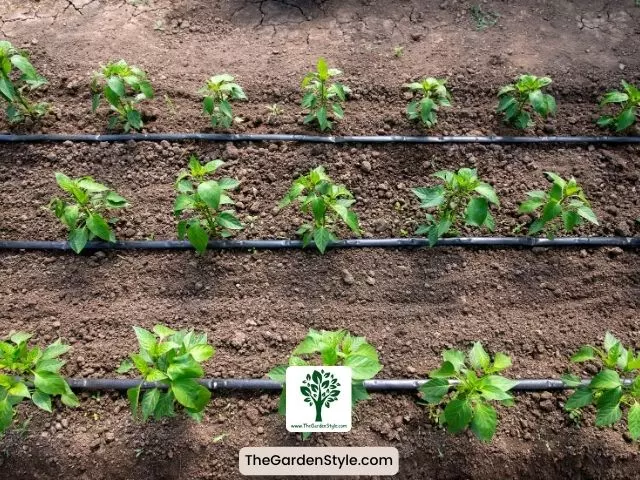
Choosing Your Irrigation Method
Choosing the right irrigation method for your garden is crucial to ensure your plants receive adequate and efficient watering. Here are the steps to help you decide on an irrigation method when starting your first garden as a beginner:
Assess Your Garden’s Size and Layout: Consider the size and layout of your garden. The irrigation needs for a small container garden will differ from those of a larger, in-ground garden. Understand the dimensions and layout to determine the most suitable irrigation method.
Understand Plant Watering Needs: Different plants have varying water requirements. Some may prefer well-drained soil, while others thrive in consistently moist conditions. Group plants with similar water needs together to simplify your irrigation strategy. Recommended reading: The BEST Time to Water Plants: Water Wisely!
Determine Water Source: Identify the water source for your garden. Whether you have access to a hose, tap, well, or rainwater collection system will influence your choice of irrigation method.
Consider Drip Irrigation: Drip irrigation is a highly efficient method that delivers water directly to the base of plants through a network of hoses or tubes with emitters. It minimizes water wastage, encourages deep root growth, and is relatively easy to install.
Explore Soaker Hoses: Soaker hoses are porous hoses that release water slowly along their length. They are placed at the base of plants or buried under mulch. Soaker hoses are cost-effective and easy to set up, making them suitable for beginners.
Sprinkler Systems: Sprinklers are commonly used for lawns but can also be effective for garden beds. Choose sprinklers with adjustable patterns to avoid wasting water on paths or non-plant areas. Be mindful of water evaporation and adjust watering times accordingly.
Hand Watering: Hand watering is a simple and direct method. Use a watering can or hose with a spray nozzle to water individual plants. While it requires more time and effort, hand watering allows for close monitoring of each plant’s needs.
Automated Timers: Consider using timers to automate your irrigation system. Timers can be installed with drip systems, soaker hoses, or sprinklers. Automation ensures consistency in watering and is particularly helpful if you have a busy schedule.
Mulching: Mulching helps retain soil moisture and reduces the frequency of watering. Consider this as a complementary method to your chosen irrigation system. Recommended reading: Different Types of Mulches: Guide and Mulch Calculator
Budget and Resources: Evaluate your budget and available resources. Drip irrigation systems may have an initial cost, but they can save water and time in the long run. Consider what you can afford and what aligns with your gardening goals.
Environmental Considerations: Be mindful of the environmental impact of your irrigation method. Collecting rainwater, for example, is an eco-friendly approach. Also, consider water conservation practices to minimize waste.
Trial and Observation: If unsure, start with a simple method and observe how well it works for your garden. Adjustments can be made over time based on the performance and needs of your plants.
There is no one-size-fits-all solution, and the best irrigation method for your garden may depend on various factors. Experiment, observe, and be willing to adapt your approach as needed to keep your plants healthy and thriving.
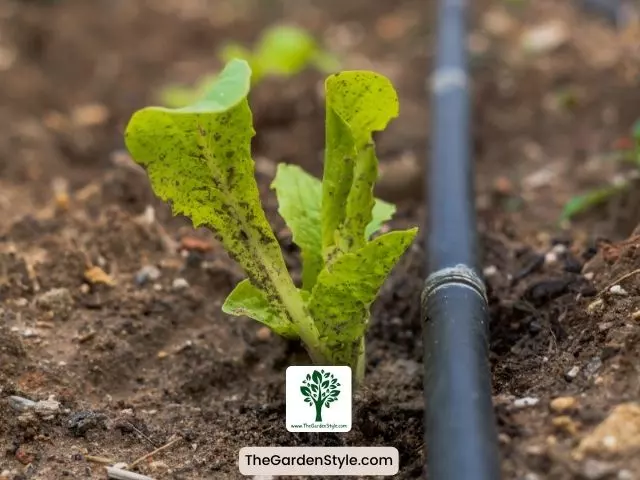
Watering System Maintenance Tips
Having established the importance of selecting an efficient irrigation method, let’s shift our focus to the maintenance of these systems to ensure their longevity and efficacy.
Whether starting a small garden or expanding an existing one, adhering to watering system maintenance tips is crucial.
- Regularly check your system for optimal functionality. This includes cleaning filters, inspecting hoses and connectors for leaks or damage, and replacing any worn-out parts promptly.
- Modify your watering schedule according to weather conditions and the needs of your plants. Overwatering or underwatering can be detrimental.
- Consider installing a rain gauge or soil moisture sensor. This will allow your garden to maintain adequate moisture levels, reducing unnecessary water usage and benefiting your plants’ health.
Regular Garden Maintenance and Care
Regular garden maintenance and care is an integral component of sustainable gardening. It encompasses a range of practices, from watering techniques to soil health. These procedures ensure the vitality and longevity of your garden. They include timely watering, essential pruning, and weeding, as well as proper fertilization. Let’s explore these key areas in more detail to equip you with the knowledge necessary for a first garden.
Optimizing Watering Strategies and Timing for a Thriving Garden
To promote the overall well-being and vitality of your garden, it is imperative to comprehend and adopt effective watering techniques and timing. Consider the following practices:
- Utilize soaker hoses or drip irrigation systems, especially in raised gardens. These methods ensure efficient water penetration into the garden soil, aiding in the seed-sowing process and benefiting plants that thrive on deep watering.
- Maintain regular vigilance over soil moisture levels. This becomes particularly crucial when preparing the soil for vegetable planting, as different vegetables have distinct moisture requirements.
- Apply mulch to preserve moisture. This not only aids in moisture retention but also acts as a barrier against weed growth, safeguarding the soil’s nutrients for your plants.
By adhering to these watering techniques and timing guidelines, you pave the way for your garden to flourish and achieve optimal growth.
Trimming vs. Pruning
“Trimming” and “pruning” are terms often used interchangeably, but they have distinct meanings in the context of gardening and landscaping:
Trimming generally refers to the act of cutting back small amounts of growth from a plant. This could involve shaping the outer edges, removing overgrown or untidy branches, or maintaining a particular size or form. Trimming is often associated with hedges, shrubs, and small plants to promote a neat appearance.
Pruning, on the other hand, is a broader term that involves selectively removing specific branches or parts of a plant for various purposes, such as shaping, promoting healthy growth, and removing diseased or dead wood. Pruning is a more intentional and strategic process, often done to encourage better structure, enhance flowering or fruiting, and maintain the overall health of the plant. Learn more about How and When to Prune Fruit Trees.
In summary, while both trimming and pruning involve cutting back plant growth, trimming typically focuses on the outer appearance and size maintenance, whereas pruning encompasses a more targeted approach to enhance the plant’s health, shape, and productivity.
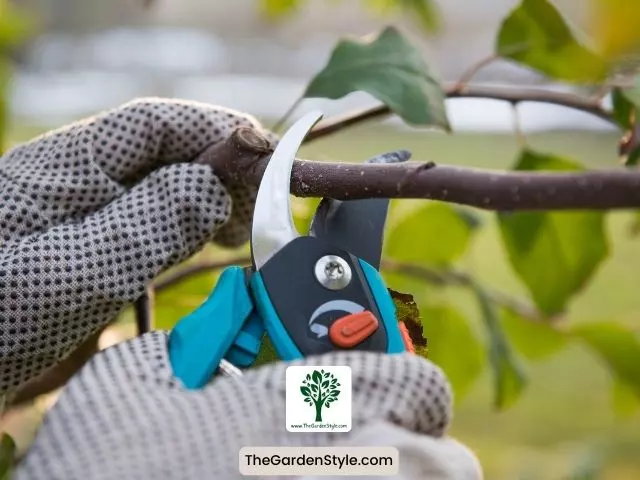
Pruning, Weeding and Mulching Essentials
Cultivating a thriving garden requires a consistent regimen of pruning (or trimming, depending on what is needed) and weeding, essential tasks in regular garden maintenance and care.
Pruning, especially for flowering plants, eliminates dead or diseased branches, promoting healthy growth. Prune to remove dead branches and shape plants. Pinch off leggy seedling tips to promote bushiness. Use sharp pruners for clean cuts, reducing plant damage.
Weeding is crucial because weeds compete for nutrients, potentially endangering your plants. Weed weekly before weeds flower and spread seeds. Apply natural mulch 2-3 inches deep to prevent. For stubborn weeds, use organic herbicides. Companion planting can help deter weeds.
Mulching can suppress weeds and conserve soil moisture, making maintenance manageable.
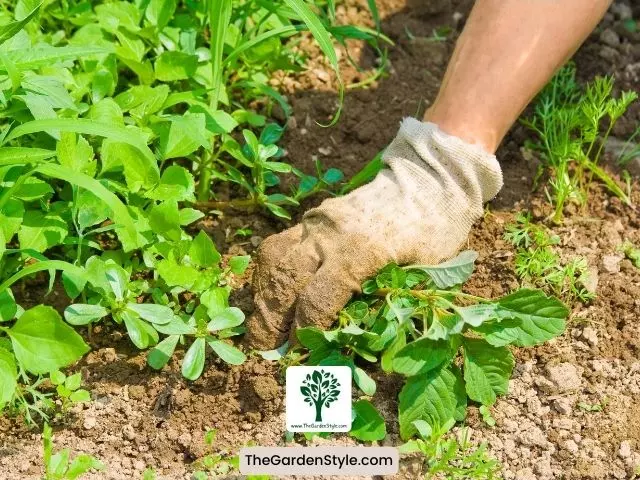
Crop Rotation
Although you will not apply the idea of crop rotation in your first garden, it’s good to be aware that crop rotation will be needed in the following years to prevent pests. Change where crop varieties are grown each season to maximize nutrition for specific plants and prevent disease buildup.
Companion Plants
A beginner gardener should consider learning about the benefits of companion plants for several reasons:
Natural Pest Control: Certain plants repel pests or attract beneficial insects that can help control pests naturally. Understanding companion planting can reduce the need for chemical pesticides and promote a healthier garden ecosystem.
Improved Pollination: Some plants rely on pollinators for fruit production. Companion planting with flowers that attract pollinators, like bees and butterflies (and even birds), can enhance pollination and increase yields for certain crops. Also, provide a small water source to keep pollinators closer.
Enhanced Nutrient Uptake: Certain plant combinations can improve nutrient uptake by promoting better soil conditions. For example, nitrogen-fixing plants can enrich the soil with essential nutrients, benefiting neighboring plants.
Weed Suppression: Companion plants can help suppress weeds by providing ground cover or releasing substances that inhibit weed growth. This reduces the need for manual weeding and conserves soil moisture.
Space Optimization: Understanding which plants complement each other in terms of growth habits and space requirements allows for more efficient use of garden space. Companion planting can help maximize yields in a limited area.
Disease Prevention: Some plants have natural properties that can help prevent diseases in nearby crops. Learning about companion planting strategies can contribute to a healthier garden environment and reduce the risk of plant diseases.
Recommended reading: Cinnamon for Plants – Benefits and Uses In The Garden
Biodiversity and Resilience: Incorporating a variety of plants in close proximity promotes biodiversity and can make the garden more resilient to environmental stresses. Companion planting fosters a balanced ecosystem that is less susceptible to pest outbreaks and disease.
Aesthetic Appeal: Companion planting can enhance the visual appeal of the garden by combining plants with complementary colors, shapes, and textures. This adds aesthetic value and makes the garden more enjoyable for the gardener.
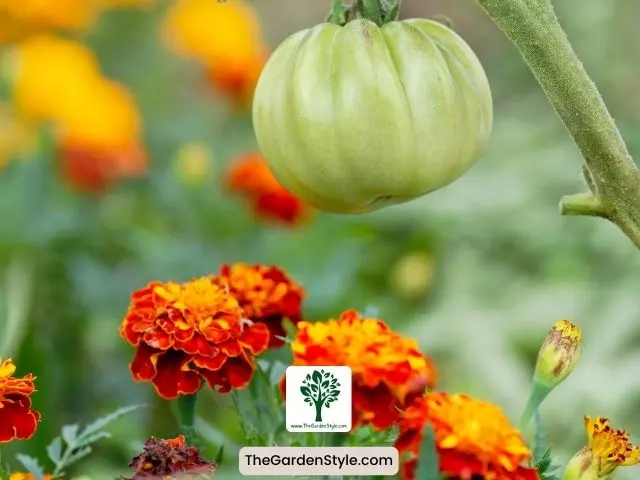
Fertilization and Soil Health
Just as pruning and weeding are vital for the overall health of your garden, proper fertilization and maintenance of soil health equally play a crucial role in ensuring robust plant growth.
Your plants need nutrient-rich soil to grow and thrive.
To achieve this, follow these steps:
- Always add plenty of organic matter to your soil. Compost, decomposed leaves, or well-rotted manure improve soil fertility and structure. Use organic fertilizers like compost tea to feed soil nutrients.
- Follow package instructions, and don’t over-fertilize.
- Fertilize at planting, mid-growth, and as plants flower and fruit.
- Measure and correct the soil pH to prevent nutrient deficiencies.
- Carry out a soil test to understand nutrient levels and deficiencies. It helps you add specific amendments to make your soil conducive for seeds to grow.
- Make sure to choose plants adapted to your garden’s climate, soil, and sunlight conditions.
Lastly, using organic fertilizers or amendments can significantly boost your garden’s productivity and health.
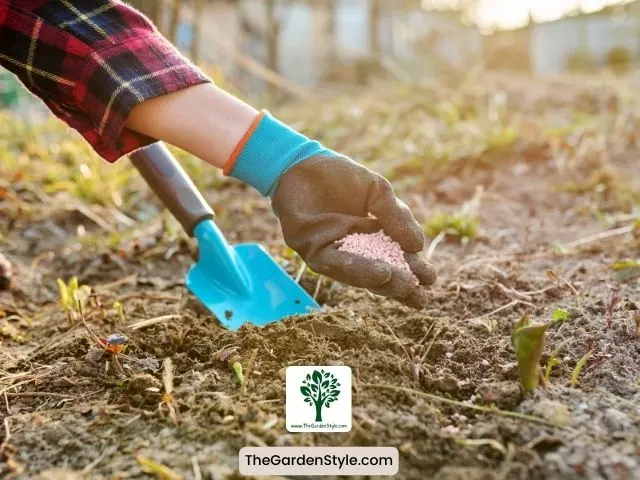
Gardening for Beginners: The Most Common Mistakes
Beginner gardeners often encounter common mistakes when starting a garden. Here are some of the most prevalent errors:
Overambitious Planning
Starting with a large garden or choosing a wide variety of plants without considering maintenance requirements can overwhelm beginners. It’s often better to start small and gradually expand as you gain experience.
Ignoring Sunlight Requirements
Neglecting to assess the sunlight conditions in the chosen garden location is a common mistake. Many plants have specific sunlight needs, and placing them in the wrong spot can hinder their growth and productivity.
Poor Soil Preparation
Failing to test and improve soil quality is a frequent error. Plants need well-draining and nutrient-rich soil. Beginners often overlook the importance of soil amendments like compost, resulting in suboptimal growing conditions.
Over or Underwatering
Inconsistent watering practices, either overwatering or underwatering, can harm plants. Beginners should establish a regular watering routine based on the specific needs of their plants. Recommended reading: The WORST Time to Water Plants (Do It Right)
Planting Too Close Together
Planting too closely can lead to overcrowding, competition for resources, and increased risk of diseases. It’s crucial to follow the recommended spacing guidelines for each plant.
Neglecting Pest Management
Overlooking pest prevention and management strategies is common. Regular monitoring for pests and implementing preventive measures can help avoid infestations that may harm plants.
Recommended readings:
- Are Ladybugs Good for the Garden?
- How to Use Diatomaceous Earth
- How to Get Rid of Gnats in Plants
- How to Get Rid of Ants in a Garden Bed
Lack of Mulching
Neglecting to apply mulch around plants is a mistake. Mulching helps retain soil moisture, suppress weeds, and regulate soil temperature, contributing to overall plant health.
Ignoring Companion Planting
Not considering the benefits of companion planting can limit the garden’s potential. Understanding which plants work well together can enhance growth, improve yields, and naturally manage pests.
Not Considering Planting Seasons
Planting without considering the appropriate season for each crop can lead to poor germination and stunted growth. Beginners should familiarize themselves with the planting calendar for their region.
Failure to Learn from Mistakes
Not observing and learning from gardening mistakes can hinder progress. Gardening is a learning process, and adapting practices based on experience is key to success.
Forgetting Garden Maintenance
Overlooking routine garden maintenance tasks, such as weeding, pruning, and soil replenishment, can result in a messy and less productive garden.
Ignoring Local Climate and Conditions
Neglecting to consider local climate conditions, such as frost dates, can lead to planting at inappropriate times. Understanding the specific challenges of the local environment is crucial for successful gardening.
Beginner Gardener’s Troubleshooting Guide: Common Issues and Solutions
Here’s a basic troubleshooting table for common issues that beginner gardeners may encounter when starting a garden.
| Issue | Possible Causes | Troubleshooting Tips |
| Poor Plant Growth | 1. Inadequate sunlight. | – Ensure plants receive the recommended amount of sunlight. |
| 2. Poor soil quality. | – Test soil and amend with compost or fertilizers as needed. | |
| 3. Overwatering or underwatering. | – Adjust the watering frequency based on plant needs. | |
| 4. Planting too closely together. | – Thin out overcrowded plants to allow for proper growth. | |
| Yellowing Leaves | 1. Nutrient deficiencies. | – Fertilize with appropriate nutrients for specific plants. |
| 2. Overwatering or poor drainage. | – Improve soil drainage and adjust watering practices. | |
| 3. Pests or diseases. | – Inspect plants for signs of pests or diseases and treat them accordingly. | |
| Wilting Plants | 1. Underwatering. | – Water plants thoroughly when the soil is dry to the touch. |
| 2. Root rot due to overwatering. | – Adjust watering to prevent waterlogged soil. | |
| 3. Pests damaging roots. | – Inspect roots for pests and treat them as needed. | |
| Pest Infestation | 1. Lack of natural predators. | – Introduce beneficial insects or use organic pest control methods. |
| 2. Overcrowded plants. | – Provide adequate spacing to reduce pest attraction. | |
| 3. Poor garden hygiene. | – Keep the garden clean and remove debris regularly. | |
| Weed Overgrowth | 1. Poor mulching practices. | – Apply a layer of mulch to suppress weed growth. |
| 2. Incomplete removal of weeds. | – Pull out weeds by the root to prevent regrowth. | |
| 3. Soil disturbance during cultivation. | – Minimize soil disturbance to reduce weed germination. | |
| Leggy or Spindly Seedlings | 1. Insufficient light. | – Provide supplemental light for indoor seedlings. |
| 2. Overcrowded seedlings. | – Thin out seedlings to allow for proper air circulation. | |
| 3. Weak or old seed stock. | – Use fresh, high-quality seeds for better germination. |
This table serves as a starting point for beginners to identify and troubleshoot common issues in their gardens. However, it’s important to note that individual plant needs may vary, and ongoing observation and learning are key to successful gardening.
Conclusion
Follow this comprehensive guide when planning your first garden for a rewarding experience.
For beginner gardeners, speaking with more experienced gardeners is a great way to get advice and improve your skills. Start small by growing something simple but rewarding, like aromatic herbs in a pot. As you gain knowledge over time by practicing new techniques, you’ll be able to grow a vegetable garden and more. Teaching others what you learn is also a great way to build expertise. Joining gardening communities connects you with fellow gardeners to share knowledge. Don’t miss the opportunity to join The Garden Style’s Community. With continued practice, you’ll be well on your way to becoming a master gardener!
Let your plants thrive using these tips all season long.
Save these pins for later so you can use this gardening guide on how to start a garden.
